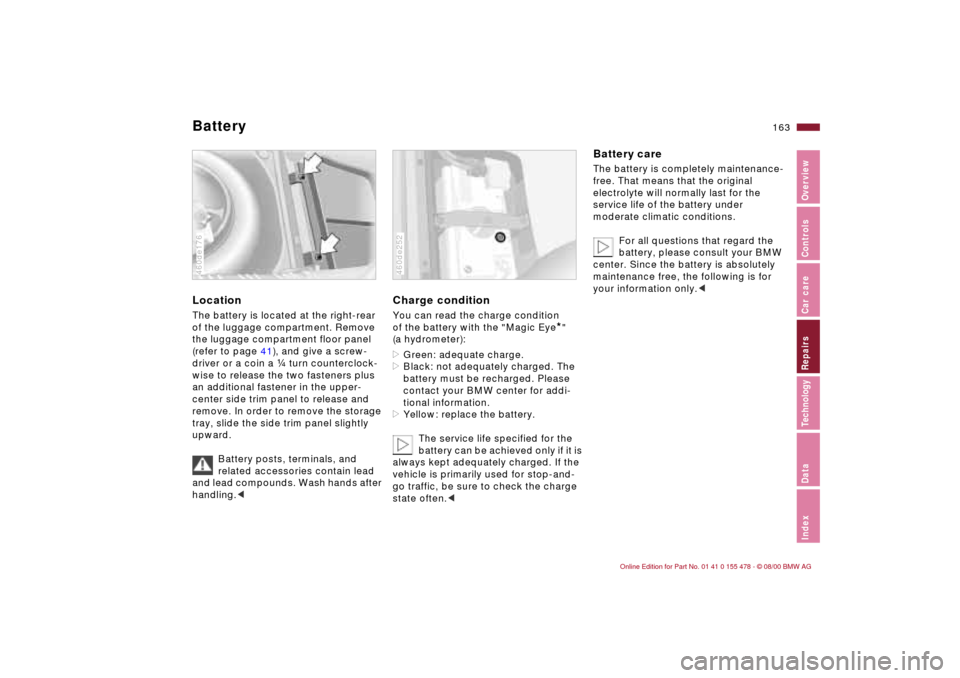2001 BMW 330Ci COUPE ABS
[x] Cancel search: ABSPage 117 of 203

117n
IndexDataTechnologyRepairsCar careControlsOverview
Disc brakesDisc brakes furnish optimum decelera-
tion and braking control and greater
fade resistance under heavy use.
When the vehicle is driven only occa-
sionally, during extended periods when
the vehicle is not used at all, and in
operating conditions where brake appli-
cations are less frequent, there is an
increased tendency for corrosion of the
discs and accumulation of contamina-
tion on the brake pads. This occurs
because the minimal pressure that must
be exerted by the pads to clean the
discs by brake applications is not
reached.
If the brake discs are corroded, they will
tend to respond to braking with a
pulsating effect that even extended
brake applications will fail to cure.
For your own safety: use only
brake pads that BMW has
approved for your particular vehicle
model. BMW cannot evaluate non-
approved brake pads to determine if
they are suited for use, and therefore
cannot ensure the operating safety of
the vehicle if they are installed.<
Driving notesWhen driving in wet conditions and in
heavy rain, it is effective to apply light
pressure to the brakes every few miles
or kilometers. Be aware of traffic condi-
tions to ensure that this maneuver does
not endanger other road users. The
heat which is generated by the brake
applications helps to dry the brake
pads and discs.
Maximum braking force is obtained
while the wheels are not locked, but
rather when they are still barely turning
immediately prior to locking. ABS main-
tains this state automatically. If the
antilock brake system ever fails, you
should revert to pumping the brakes
(refer to page 120).
Extended or steep mountain descents
should be driven in the gear in which
only minimal periodic brake applica-
tions is required. This avoids excessive
strain on the brakes and possible
impairment of the braking effect.
You can further increase the engine's
braking effect by selecting a lower gear,
downshifting as far as first gear.
When driving a vehicle with automatic
transmission, you can still downshift
into first gear. Refer to page 67.If engine braking should prove to be
inadequate, you should still avoid
extended, continuous braking. Instead
of maintaining low to moderate pres-
sure over an extended period of time,
you should decelerate by applying
more substantial pressure to the brake
pedal (watch for following traffic),
releasing the pedal, and then repeating
the application (staggered braking). The
cooling phases between active braking
intervals prevent the brakes from over-
heating, thus ensuring that full braking
capacity remains available at all times.
Do not coast with the clutch
depressed or with the shift lever
or selector lever in Neutral. Do not drive
with the engine shut off. The engine
provides no braking effect when the
clutch is depressed or the transmission
is in Neutral, and there is no power-
assist for braking or steering when the
engine is not running. Never allow floor
mats, carpets or any other objects to
protrude into the area around the brake,
clutch or accelerator pedals, which can
obstruct pedal travel.<
Page 120 of 203

120n
Winter operationBrakesWinter road conditions substantially
reduce the amount of traction available
between the tires and the road surface;
the resulting increase in braking
distance is considerable and should
always be kept in mind.
ABS is intended to prevent the wheels
from locking during brake applications,
thus helping to maintain vehicle stability
and steering response.
If the ABS does not respond in a critical
braking situation and the wheels lock:
reduce the pressure on the brake pedal
until the wheels just start to roll again
while still maintaining enough force to
continue braking.
Then increase the pedal pressure,
reduce the pressure when the wheels
lock, reapply pressure etc.
This staggered braking procedure will
reduce stopping distances while
helping you maintain steering control.
You can then attempt to steer around
hazards after you have reduced pres-
sure on the brake pedal.Do not shift down on slick road
surfaces. Doing so could cause
the rear wheels to lose traction and
skid, that could result in the loss of
vehicle control.<
Depress the clutch during hard
braking on road surfaces that
provide only poor or uneven traction.<
Skid control Depress the clutch and let up on the
accelerator pedal, or place the selector
lever for the automatic transmission in
the "Neutral" position. Countersteer
carefully and attempt to regain control
of the vehicle.
ParkingEngage 1st or reverse gear. If your
vehicle is equipped with an automatic
transmission, place the selector lever in
Park. On vehicles with manual trans-
mission, also apply the parking brake
when parking on inclined surfaces. In
order to prevent the parking brake pads
from locking due to frost or corrosion,
dry them by gently applying the parking
brake as the vehicle is coming to a
stop. Make sure that following traffic is
not endangered.
The brake lamps do not come
on when the parking brake is
applied.<
Page 125 of 203

125n
IndexDataTechnologyRepairsCar careControlsOverview
Wheel and tire combinations The right choice Use only BMW-approved tires, begin-
ning on page 127.
Due to the high speeds this vehicle can
reach, the use of specific brands,
specifications and sizes is mandatory.
Consult any BMW center for details.
Comply with local/national regulations.
The correct wheel/tire combina-
tion has an effect on the different
systems such as ABS, ATC,
ASC+T/DSC and ADB/DBC, whose
functioning would be otherwise im-
paired if the incorrect wheel/tire combi-
nations were used.
For this reason, use only tires of the
same manufacture and tread configura-
tion. In the event of a flat tire, for
example, remount the approved wheel/
tire combination as soon as possible.<
Codes on the tires and wheels The tire codes will aid you in selecting
the correct tire.
The codes on radial tires:
The speed rating indicates the approved
maximum speed for the tire.
Summer tires:
S = up to 112 mph (180 km/h)
T = up to 118 mph (190 km/h)
H = up to 130 mph (210 km/h)
V = up to 150 mph (240 km/h)
W = up to 167 mph (270 km/h)
Y = up to 187 mph (300 km/h)
ZR = over 150 mph (240 km/h) Example:
Nominal width
in mm
Aspect ratio in X
Radial tire ID code
Rim diameter in inches
Load rating
(not on ZR tires)
Speed rating
(before R on ZR tires)
225/50 R
1692W
Winter tires and all-season tires:
Q M+S = up to 100 mph (160 km/h)
T M+S = up to 118 mph (190 km/h)
H M+S = up to 130 mph (210 km/h)
Codes stamped on light-alloy wheels:
Protect tire valve from dirt by using
screw-on valve stem caps. Dirt in the
valves frequently leads to slow leaks. Example:
Rim width
in inches
Code letter for
flange type
Symbol for full-drop
center rim
Rim diameter in inches
Hump on the 2 rim shoulders
7 x 16 H 2
J
Page 138 of 203

138n
Coolant Brake fluidAdding coolant Wait until the engine cools before
removing the cap from the expansion
tank. The needle of the coolant
temperature gauge in the instrument
cluster must be located in the blue
zone. If it is not, there is a danger of
scalding.
1 Turn the cap slightly counterclock-
wise in order to allow accumulated
pressure to escape. Then open.
2 If the coolant is low, slowly add
coolant until the correct level is
reached Ð do not overfill.
The coolant is a mixture of water and
extended-duty antifreeze with corrosion
inhibitor. Always maintain the pre-
scribed all-season 50:50 mixture ratio
for year-round protection against inter-
nal corrosion. No other additives are
required.
Replace the coolant every four years.If the brake warning lamp comes on
and the parking brake has been
released:
Check the brake fluid level and if nec-
essary, fill it back up to the "MAX" mark.
For adding brake fluid or for determin-
ing and correcting the cause of brake
fluid loss, consult your BMW center.
Your BMW center is familiar with the
specifications for factory-approved
brake fluids (DOT 4).
Brake fluid loss can result in extended
pedal travel. Comply with the informa-
tion provided on page 118.
460de128
Brake fluid is hygroscopic, that is,
it absorbs moisture from the air
over time.
In order to ensure the safety and reli-
ability of the brake system, have the
brake fluid changed every two years by
an authorized BMW center. Refer also
to the Service and Warranty Information
Booklet (US models) or the Warranty
and Service Guide Booklet (Canadian
models). Brake fluid is hazardous to
health and damages the vehicle's paint.
You should always store it in its original
container and in a location that is
inaccessible to children.
Do not spill the fluid and do not fill the
brake fluid reservoir beyond the "MAX"
mark. The brake fluid could ignite upon
contact with hot engine parts and
cause serious burns.<
Comply with the applicable
environmental laws regulating
the disposal of brake fluid.<
Page 163 of 203

163n
IndexDataTechnologyRepairsCar careControlsOverview
Battery LocationThe battery is located at the right-rear
of the luggage compartment. Remove
the luggage compartment floor panel
(refer to page 41), and give a screw-
driver or a coin a f turn counterclock-
wise to release the two fasteners plus
an additional fastener in the upper-
center side trim panel to release and
remove. In order to remove the storage
tray, slide the side trim panel slightly
upward.
Battery posts, terminals, and
related accessories contain lead
and lead compounds. Wash hands after
handling.<460de176
Charge conditionYou can read the charge condition
of the battery with the "Magic Eye
*"
(a hydrometer):
>Green: adequate charge.
>Black: not adequately charged. The
battery must be recharged. Please
contact your BMW center for addi-
tional information.
>Yellow: replace the battery.
The service life specified for the
battery can be achieved only if it is
always kept adequately charged. If the
vehicle is primarily used for stop-and-
go traffic, be sure to check the charge
state often.<
460de252
Battery careThe battery is completely maintenance-
free. That means that the original
electrolyte will normally last for the
service life of the battery under
moderate climatic conditions.
For all questions that regard the
battery, please consult your BMW
center. Since the battery is absolutely
maintenance free, the following is for
your information only.<
Page 192 of 203

Everything from A to ZA
ABS (Antilock Brake
System)22,115
ABS, fault116
Accessories6
Activated-charcoal
filter100,166
Adaptive Transmission
Control (ATC)67,174
Adding
engine oil135
washer fluid134,187
Adjusting
backrest48
head restraints48
lumbar support49
steering wheel52
temperature92,98
Air conditioner90
Air distribution92,98
Air nozzles90,96
Air outlets90,96
ventilation90,96
Air pressure122
Air supply92,99
Airbags21,57,146,175
sitting properly58
Alarm system42
Antenna121
Diversity176
Antifreeze137
radiator119 Antilock Brake System
(ABS)22,115
Anti-theft alarm system42
Approved weight and load
capacities186
Approved wheel and tire
specifications127
Aquaplaning113,122
Armrest102
ASC+T (Automatic Stability
Control plus
Traction)22,82,175
Ashtray
front104
rear105
ATC (Adaptive Transmission
Control)67,174
Attach vacuum cleaner105
AUC (Automatic
recirculated-air
control)99
Automatic car washes141
Automatic climate
control96
remove window
condensation99
Automatic cruise control73
Automatic dimming, interior
rearview mirror53
Automatic recirculated-air
control (AUC)99 Automatic Stability Control
plus Traction
(ASC+T)22,82,175
Automatic transmission with
Steptronic21,67
Automatic windshield
washer71
Average consumption79
Average speed80
Avoiding unwanted
alarm43
Axle loads186
B
Backrest, releasing49
Backup lamps66
bulb replacement155
Battery163,188
capacity188
charge current20
charging165
discharged168
removal and
installation164
Battery safety terminal164
Battery terminal164
Belts55
Blower92,99
BMW High Performance
Synthetic Oil136
BMW Maintenance
System140 BMW sports seat49
Bore184
Brake fluid138
Brake hydraulic system20
Brake lamps, bulb
replacement155
Brake pads22
Brake system118
Brakes117
malfunctions118
Break-in procedures112
Bulb replacement152
Bulbs152
C
California Proposition
65 Warning148
Capacities187
Car Memory54
Car radio121
refer also to the separate
Owner's Manual
Car radio
reception121,176
Car vacuum cleaner105
Car wash141
Care
exterior142
interior144
Care of upholstery145
Care of wool velour145
Page 194 of 203

Everything from A to ZEngine oil135
adding135
capacity187
consumption135
level check135
pressure20
quality136
specifications136
viscosity136
Engine speed184
Engine, starting63
Engine, switching off64
Entry to the rear49
Exterior mirrors52
Eyelets, towing169 F
Failure messages77
Fault displays77
Fault, ABS116
Filling capacities187
Filling the washer
reservoir187
First-aid kit25
Fittings, towing and tow
starting169
Flashlight102
Flat tire122,159
Floor mat41
Floor panel, lift and hook41
Fog lamps88 Folding rear backrest106
Follow-Me-Home lamps87
Footbrake117
Footwell lamps88
bulb replacement158
Front fog lamps, bulb
replacement155
Front seat, adjusting47
Frost protection,
radiator137
Fuel27
Fuel consumption79
Fuel consumption
display76
Fuel filler cap26
Fuel filler door26
unlock in case of electrical
fault167
Fuel gauge76
Fuel quality27
Fuel reserve indicator
lamp76
Fuel specifications27
Fuel tank capacity187
Fuel tank gauge76
Functional status180
Fuses166
G
Gasoline27
Gasoline gauge76
Glove compartment102
Glove compartment lamp
bulb replacement158
Gross vehicle weight186 H
Handbrake65
Handsfree system104
Hazard warning flashers25
Hazard warning triangle25
Head restraints48
Headlamp cover,
care141,153
Headlamp flasher70,88
Headlamp washer
system72,134,187
Headlamps87
Heated seats101
Heating, rapid94
Heavy loads108
Height185
HiFi system Ð harman
kardon101
High beams23,70,88
bulb replacement153
High Performance Synthetic
Oil136
High-mount brake lamp157 Hood130
release130
Horn17
Hubcap161
Hydraulic Brake assistent,
refer to DBC
I
Ice warning79
Icy roads79
Identification,
tires125,127
Ignition key32
Ignition lock63
Imprint4
Indicator lamps20
Inflation
pressure27,85,122
monitoring27,85,179
INSPECTION76
Instrument cluster18
Instrument panel16,18
Instrument panel lighting87
Interaxle tire rotation124
Interface socket for Onboard
Diagnostics149
Interference, cellular
phones121
Interior lamps36,88
bulb replacement157
remote control36